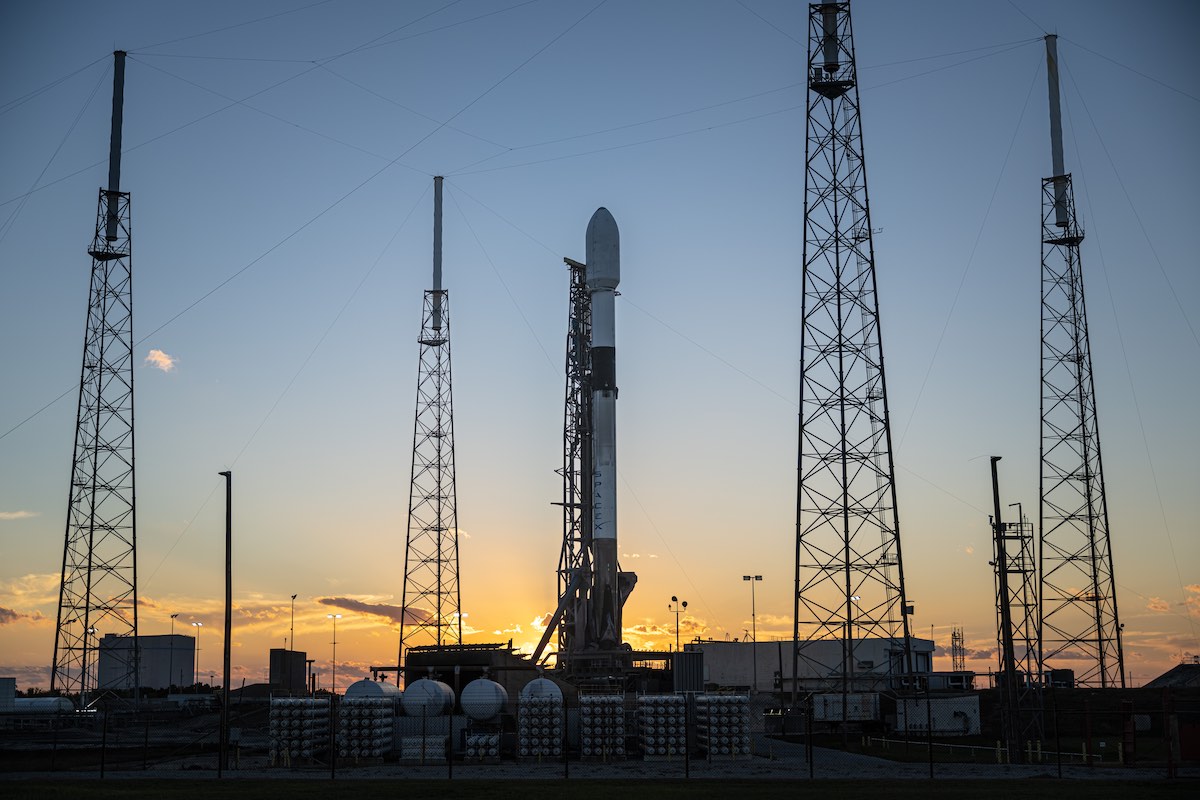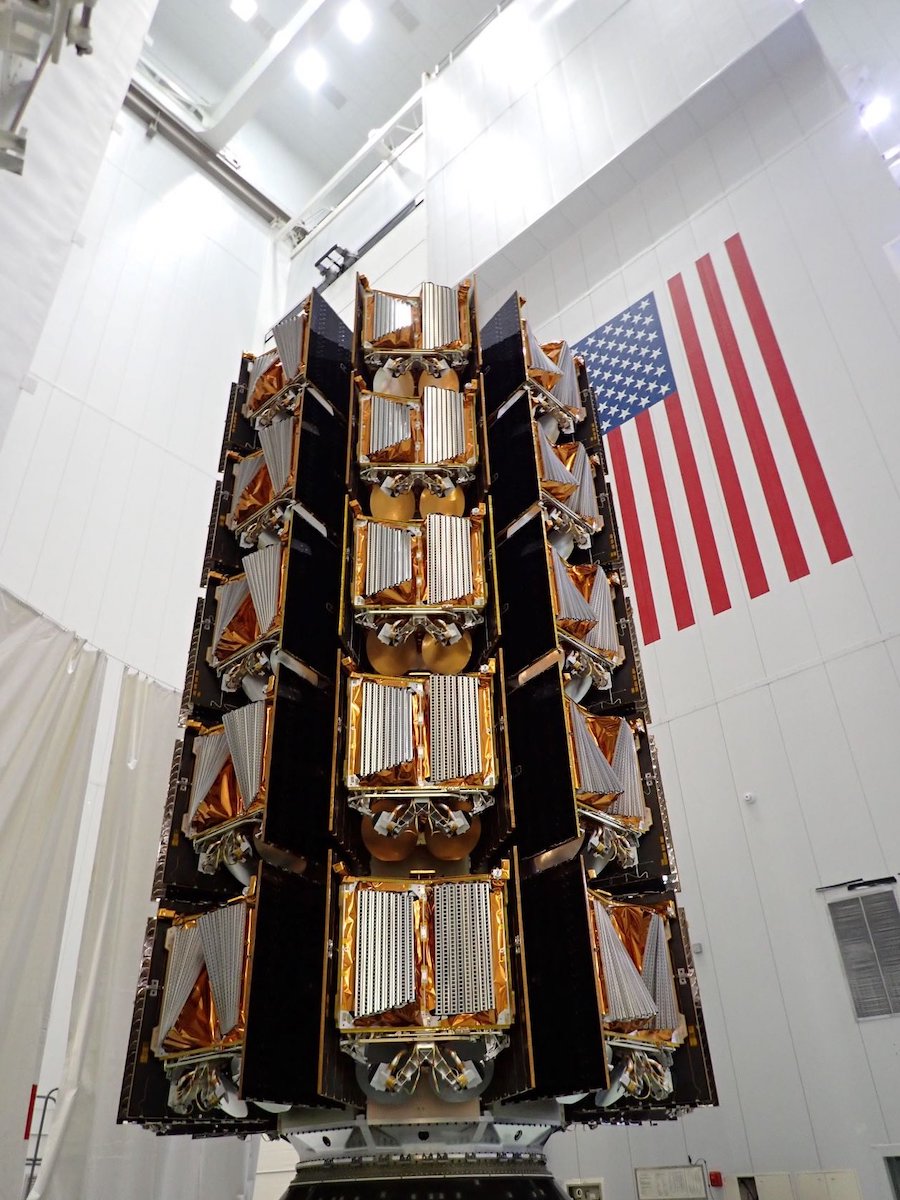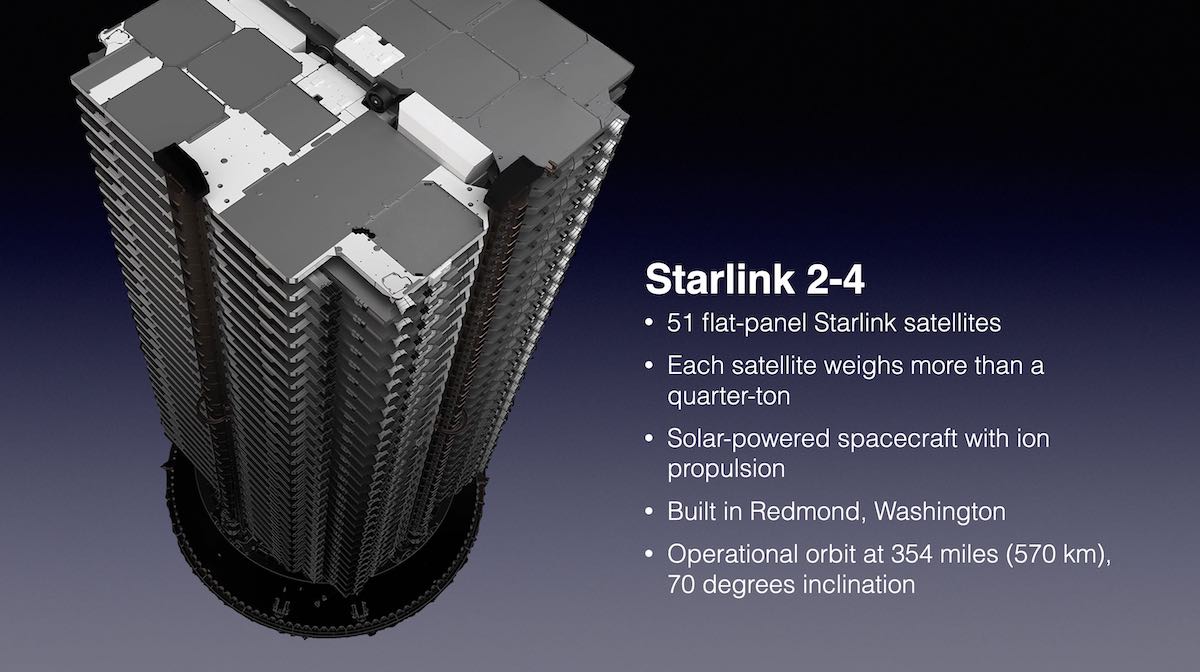Space News & Blog Articles
Live coverage: SpaceX counting down to two launches tonight
Watch our live coverage of the countdown and launch of a SpaceX Falcon 9 rocket at 11:50 p.m. EST (0450 GMT) from Space Launch Complex 40 at Cape Canaveral Space Force Station, Florida, with 40 OneWeb internet satellites. Our live stream will also cover the launch of a Falcon 9 rocket from Vandenberg Space Force Base at 12:35 a.m. EST (9:35 p.m. PST; 0535 GMT) with 51 Starlink internet satellites. Follow us on Twitter.
SFN Live
SpaceX is counting down to two launches from California and Florida tonight. A Falcon 9 rocket is set to take off from Cape Canaveral with 40 broadband satellites for OneWeb at 11:50 p.m. EST (0450 GMT). Weather permitting, a Falcon 9 rocket will take off from Vandenberg Space Force Base 45 minutes later at 12:35 a.m. EST (9:35 p.m. PST; 0535 GMT) with 51 Starlink internet satellites.
The back-to-back missions would set a record for the shortest time between two SpaceX launches, but the weather forecast at Vandenberg is iffy, at best, for liftoff Monday night.
There’s just a 30% chance of acceptable conditions for liftoff of the Falcon 9 rocket from Vandenberg on the Starlink 2-4 mission, with high winds and storms bringing flooding rains to California. SpaceX says it has a backup launch opportunity at 8:02 p.m. PST Tuesday (11:02 p.m. EST; 0402 GMT).
The weather forecast in Florida is more favorable, with a greater than 90% chance of good weather for launch of the 40 OneWeb satellites Monday night.
Different teams of launch engineers will oversee the simultaneous countdowns at each spaceport. The launch teams will begin loading super-chilled, densified kerosene and liquid oxygen propellants into each Falcon 9 vehicle at T-minus 35 minutes.
Helium pressurant will also flowed into each rocket in the last half-hour of the countdown. In the final seven minutes before liftoff, the Falcon 9’s Merlin main engines will be thermally conditioned for flight through a procedure known as “chilldown.” The Falcon 9’s guidance and range safety systems will also be configured for launch.
After liftoff, the Falcon 9 rockets will each vector 1.7 million pounds of thrust — produced by nine Merlin engines — to steer downrange. The launch from California will head southeast over the Pacific Ocean, flying west of Baja California to target an orbit inclined 70 degrees to the equator. The Falcon 9 departing from pad 40 at Cape Canaveral will initially head southeast, then turn south to fly parallel to Florida’s east coast, aiming for a polar orbit at an inclination of 87 degrees.
 SpaceX’s Falcon 9 rocket on pad 40 in preparation for launch of the OneWeb 16 mission. Credit: Michael Cain / Spaceflight Now / Coldlife Photography
SpaceX’s Falcon 9 rocket on pad 40 in preparation for launch of the OneWeb 16 mission. Credit: Michael Cain / Spaceflight Now / Coldlife Photography
The Falcon 9 rockets will follow similar flight profiles in the first few minutes of each mission. The launchers will exceed the speed of sound in about one minute, then shut down their nine main engines nearly two-and-a-half minutes after liftoff.
On both missions, the booster stage will separate from the Falcon 9’s upper stage, then fire pulses from cold gas control thrusters and extend titanium grid fins to help steer the vehicle back into the atmosphere.
For the Starlink 2-4 mission from California, two braking burns will slow the rocket for landing on the drone ship “Just Read the Instructions” downrange in the Pacific Ocean approximately nine minutes after liftoff. The booster on the OneWeb launch from Florida will reverse course, using a “boost back” burn to head back to Cape Canaveral for touchdown on Landing Zone 1.
The lighter weight of the 40 OneWeb satellites will allow the Falcon 9 booster to set aside enough fuel for the return to launch site maneuver, which requires an extra burn to head back to Cape Canaveral.
Recovery ships are also on station in the Atlantic and Pacific Ocean to retrieve the Falcon 9’s payload fairings after jettisoning from the rocket.
The Starlink 2-4 mission from California will debut a brand new Falcon 9 booster, designated B1075, making its first flight to space. The OneWeb launch from Florida will use a first stage booster known as B1076, making its second launch and landing.
The Starlink mission will aim to deploy the 51 internet satellites into Group 2 of the Starlink constellation.
SpaceX’s first-generation Starlink fleet is spread out into five groups, or orbital shells, between 335 miles and 354 miles in altitude. The first-generation Starlink shells are inclined at different angles to the equator, with some satellites orbiting between 53 degrees north and south latitude, and others in orbits flying from pole-to-pole.
The Starlink satellites on this launch, named Starlink 2-4, will fly in an orbit inclined 70 degrees to the equator. It’s the second launch into Group 2, following a mission in September 2021 that also carried 51 Starlink spacecraft into orbit.
SpaceX began launching satellites into its second-generation Starlink constellation, called Gen2, last month. The Starlink 2-4 mission will continue filling out the first-generation Starlink fleet.
 File photo from a previous mission showing 40 OneWeb satellites mounted on a dispenser before encapsulation inside a SpaceX payload fairing. Credit: OneWeb
File photo from a previous mission showing 40 OneWeb satellites mounted on a dispenser before encapsulation inside a SpaceX payload fairing. Credit: OneWeb
After the launch from Vandenberg, the Falcon 9’s guidance computer will aim to deploy the Starlink satellites into an elliptical orbit with an altitude ranging between 132 miles and 208 miles (213-by-335 kilometers). After separating from the rocket, the 51 Starlink spacecraft will unfurl solar arrays and run through automated activation steps, then use ion engines to maneuver into their operational orbit at 354 miles (570 kilometers) altitude.
The 51 Starlink internet satellites on-board the rocket will bring the total number of Starlink spacecraft launched to 3,717. About 3,100 of the satellites are currently operational, with nearly 200 more maneuvering into their operating orbits after recent launches, according to Jonathan McDowell, an astronomer who expertly tracks spaceflight activity.
The mission departing from Cape Canaveral will target a 373-mile-high orbit inclined 87 degrees to the equator. The upper stage of the Falcon 9 will release the 40 OneWeb satellites beginning about 59 minutes after liftoff.
The OneWeb launch from Cape Canaveral will be the second of four planned SpaceX missions for the broadband internet provider, which suspended launches on Russian Soyuz rockets last year after Russia’s invasion of Ukraine. Within weeks, OneWeb signed new contracts with SpaceX and New Space India Ltd., or NSIL, for launches on Falcon 9 and Indian GSLV Mk.3 rockets to finish building out the company’s satellite network.
The 40 satellites on-board the Falcon 9 rocket will bring the total number of OneWeb spacecraft launched to 544. OneWeb needs 588 operational satellites to complete its first-generation broadband network, or a total of nearly 650 spacecraft when counting spares.
Adding more relay stations to the constellation extends the network’s reach. OneWeb already provides internet services to communities in Alaska, Canada, and and Northern Europe where terrestrial fiber connectivity is unavailable. The 40 satellites on Monday night’s launch will help put Southern Europe, the United States, North Africa, the Middle East, Japan, and parts of Australia and India within OneWeb’s reach.
OneWeb’s contract with SpaceX was surprising to many satellite industry watchers because OneWeb is an indirect competitor in the broadband market. SpaceX sells Starlink service directly to consumers, while OneWeb sells to enterprises, internet service providers, maritime companies, and airlines to provide connectivity for entire businesses or communities.
 The Starlink 2-4 mission will carry 51 more Starlink internet satellites into orbit. Credit: Spaceflight Now
The Starlink 2-4 mission will carry 51 more Starlink internet satellites into orbit. Credit: Spaceflight Now
ROCKETS: Falcon 9 (B1075.1 & B1076.2)
PAYLOADS: 51 Starlink satellites (Starlink 2-4); 40 OneWeb satellites (OneWeb 16)
LAUNCH SITES: SLC-4E, Vandenberg Space Force Base, California; SLC-40, Cape Canaveral Space Force Station, Florida
LAUNCH DATES: Jan. 9, 2023
LAUNCH TIME: 11:15:50 p.m. EST (0415:50 GMT); 11:50:17 p.m. (0450:17 GMT)
WEATHER FORECAST: 30% chance of acceptable weather at Vandenberg; Greater than 90% chance of acceptable weather at Cape Canaveral
BOOSTER RECOVERY: “Just Read the Instructions” drone ship west of Baja California; Landing Zone 1 at Cape Canaveral Space Force Station
LAUNCH AZIMUTH: Southeast from Vandenberg; Southeast, then south from Cape Canaveral
TARGET ORBIT: 132 miles by 208 miles (213 kilometers by 335 kilometers), 70 degrees inclination for Starlink 2-4; 373 miles (600 kilometers), 87 degrees inclination for OneWeb 16
LAUNCH TIMELINE FOR STARLINK 2-4:
T+00:00: Liftoff T+01:12: Maximum aerodynamic pressure (Max-Q) T+02:26: First stage main engine cutoff (MECO) T+02:30: Stage separation T+02:36: Second stage engine ignition T+02:41: Fairing jettison T+06:43: First stage entry burn ignition (three engines) T+07:03: First stage entry burn cutoff T+08:19: First stage landing burn ignition (one engine) T+08:39: Second stage engine cutoff (SECO 1) T+08:43: First stage landing T+29:00: Starlink satellite separationLAUNCH TIMELINE FOR ONEWEB 16:
T+00:00: Liftoff T+01:12: Maximum aerodynamic pressure (Max-Q) T+02:18: First stage main engine cutoff (MECO) T+02:21: Stage separation T+02:28: Second stage engine ignition T+02:34: First stage boost back burn ignition T+03:21: First stage boost back burn cutoff T+03:34: Fairing jettison T+06:20: First stage entry burn ignition T+06:36: First stage entry burn cutoff T+07:27: First stage landing burn ignition T+07:56: First stage landing T+08:32: Second stage engine cutoff (SECO 1) T+55:14: Second stage engine restart (SES 2) T+55:17: Second stage engine cutoff (SECO 2) T+58:49: Separation of first OneWeb satellites T+01:35:17: Separation of final OneWeb satellitesMISSION STATS:
196th and 197th launch of a Falcon 9 rocket since 2010 205th and 206th launch of Falcon rocket family since 2006 2nd launch of Falcon 9 booster B1076 1st launch of Falcon 9 booster B1075 168th SpaceX launch from Florida’s Space Coast 109th Falcon 9 launch from pad 40 164th launch overall from pad 40 33rd SpaceX launch from Vandenberg Space Force Base 135th flight of a reused Falcon 9 booster 68th Falcon 9 launch primarily dedicated to Starlink network 2nd SpaceX launch for OneWeb 16th overall launch for OneWeb 2nd and 3rd Falcon 9 launch of 2023 2nd and 3rd launch by SpaceX in 2023 1st orbital launch from Vandenberg Space Space Base in 2023 2nd orbital launch from Cape Canaveral in 2023This email address is being protected from spambots. You need JavaScript enabled to view it. the author.
Follow Stephen Clark on Twitter: @StephenClark1.
When you subscribe to the SpaceZE News Feed, we will send you an e-mail when there are new updates on the site so you wouldn't miss them.

